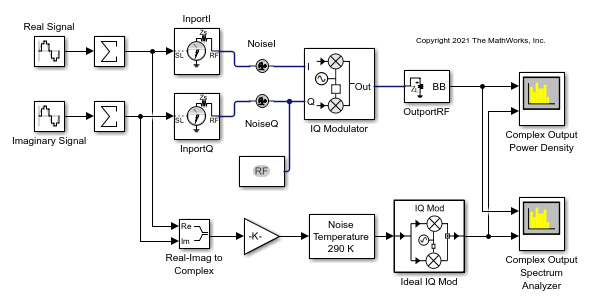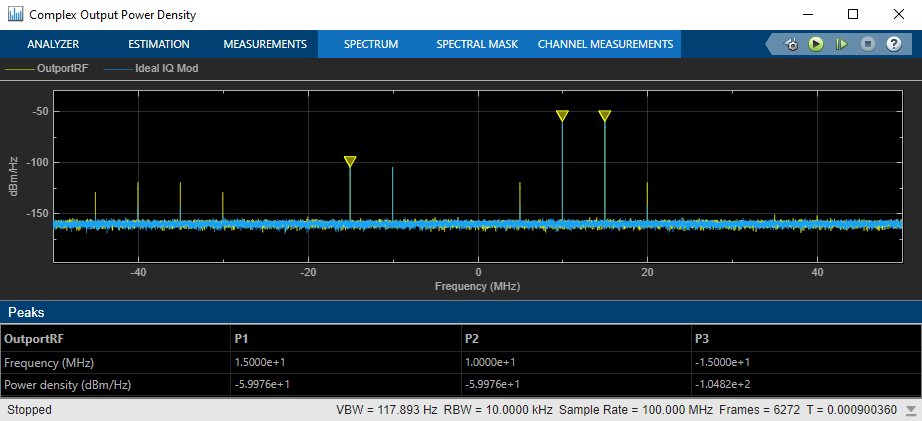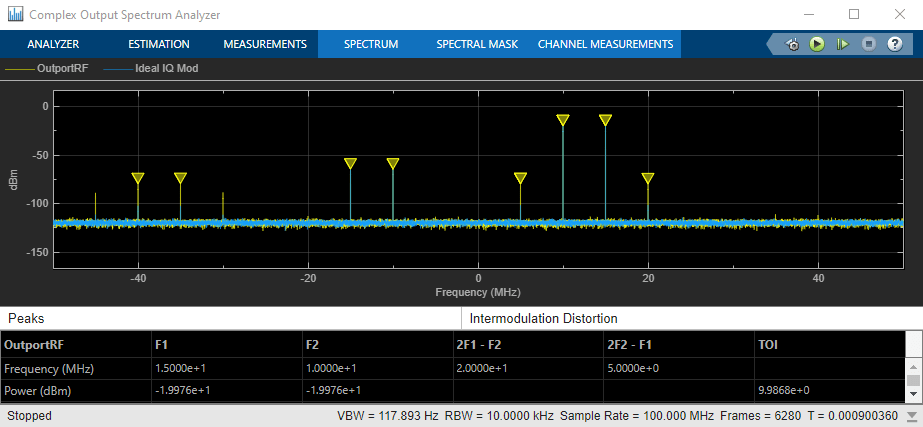Modulate Quadrature Baseband Signals Using IQ Modulators
This example shows how to modulate quadrature baseband signals using two different RF Blockset™ blocks. You can use either an idealized baseband Mixer block or a circuit envelope IQ Modulator block in your model to modulate quadrature baseband signals to the RF level. Observe the impairments in the modulated output signal due to gain imbalance, third-order intercepts (OIP3) and system noise in the complex output power density and output power spectrum analyzers.
The input in-phase and quadrature baseband signals are each composed of two tones at 10 MHz and 15 MHz and the power of each baseband signal is -30 dBm. When using a circuit envelope IQ Modulator block to modulate the signal, you must use Inport and Outport blocks to set the input and output carrier frequencies. The explicit noise sources in the model set the noise floor in each signal branch.
Set Parameters
For idealized baseband Mixer block
Mixer type —
IQ ModulatorSideband —
UpperGain (dB) —
10dBIIP3 (dBm) —
10dBmSelect Include mixer noise
I/Q gain imbalance (dB) —
0.1dBNoise figure (dB) —
3.9752dB
The Noise figure (dB) is calculated using this equation
(Room Temperature Noise Floor,Boltmanns x 290) – dB_to_dBm – CE_IQModulator_Noise_Floor – IDBB_Mixer_Conversion_Gain
= 10 x log10(1.3806452e-23 x 290) – 30 – 160 – 10 = 3.9752 dB
For circuit envelope IQ Modulator block
Available power gain —
10dBLocal oscillator frequency —
2GHzIP3 —
10dBmI/Q gain mismatch —
0.1dBLO to RF Isolation —
infdBNoise Floor —
–160dBm/HzSelect Add Image Reject filter
Since the input signals are baseband signals, the inport blocks Carrier frequencies are set to 0 and the input signal power is interpreted correctly. For the Ideal Baseband Mixer branch, a Gain block with Gain equal to 1/(sqrt(2)) is required. If the input signals are complex baseband, then the gain is set to 1/2.

Run the model and observe the output of the Spectrum Analyzer blocks.
Analyze Complex Output Power Density Plot

In the complex output power density spectrum analyzer plot, the noise floor of the signal is at – 160 dBm/Hz for the two output signals OutportRF and Ideal IQ Mod.
Analyze Complex Output Spectrum Analyzer Plot

In the complex output spectrum analyzer plot, the modulated signal along with other signal tones produced by the impairments are shown. The output power levels at 10 MHz and 15 MHz are – 20 dBm. The level of the other output tones are correct for circuit envelope, since it is a multi-tone simulator. Any differences between the modulated signals, 10 MHz and 15 MHz, result from different model implementations for the I/Q gain and phase mismatch. You can calculate the output power level using this formula:
Output_Power_Level(dBm) = Input_Power_Level(dBm) + Gain(dBm) = – 30 + 10 = – 20